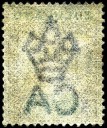
Now that we know what a stamp watermark is, let’s talk about how we can detect one. A previous article briefly outlined how you can use watermark detector fluid (see article FAQ-What is a stamp watermark?). Is this the only method available to stamp enthusiasts?
Here are 5 different ways to detect a watermark on a stamp:
1) Not always reliable, but certainly the simplest way, is to hold the stamp up to a bright light with the back of the stamp facing you. In some instances bright light will show through the thinner areas of the paper and reveal a watermark. You can also try laying the stamp face side down on a black surface. The darker background sometimes shows through the watermark.




